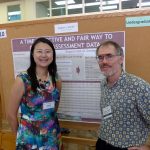Collecting Evidence of Student Learning
This workshop will introduce you to common evidence collection methods used in program assessment: exams, portfolios, surveys, interviews, …

This workshop will introduce you to common evidence collection methods used in program assessment: exams, portfolios, surveys, interviews, …

Assessment efforts at the University of Hawaiʻi at Mānoa strive to help departments meet learning objectives the departments …

College of Education (COE) programs select six to eight key program assessments to systematically measure, collect and analyze …

This poster reviews Mathematics’ assessment activities. It describes the program goals, assessment plan, and current activities; presents a …

First-Year Programs (FYP) utilizes multiple approaches to assess student learning outcomes and program success. Institutional data are used …
This workshop is co-sponsored by the Assessment and Curriculum Support Center, Graduate Division, and the Graduate Council. Wondering …
Last Updated: 4 March 2024. Click here to view archived versions of this page. The data or evidence in a …
On this page: 1. What is a portfolio? Back to Top A portfolio is a systematic collection of …